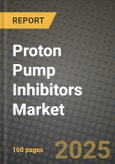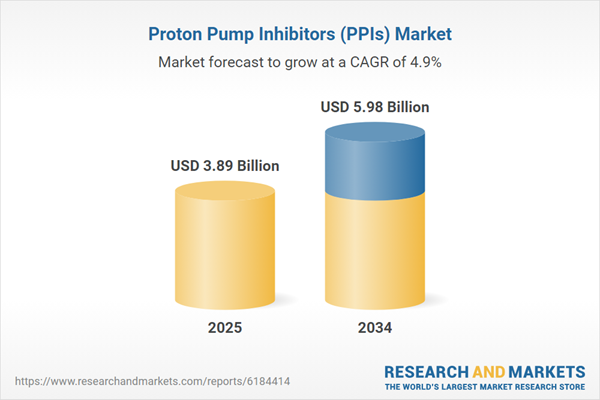Proton Pump Inhibitors (PPIs) Market
Proton pump inhibitors (PPIs) remain the backbone of acid-related therapy across gastroesophageal reflux disease, peptic ulcer disease, NSAID-associated ulcer prophylaxis, and H. pylori eradication regimens. The category spans multiple well-known molecules offered in prescription and OTC forms, oral solids, oral suspensions, and hospital IV presentations. Demand is anchored in chronic GERD management and intermittent self-care for heartburn, with hospital use in stress-ulcer prophylaxis and acute bleeding protocols. Key trends include ongoing generic penetration, brand-to-OTC switches that expand access, pharmacist-led triage in retail channels, and growing attention to appropriate duration, step-down strategies, and deprescribing in low-risk patients. Clinical practice emphasizes symptom control, mucosal healing, and adherence to eradication protocols, while payers tighten prior authorization and prefer lower-cost generics or OTC substitution. Safety stewardship - addressing nutrient interactions, fracture and infection risk signals, and drug-drug considerations - shapes labeling, HCP education, and patient materials. Competitive dynamics feature global generics manufacturers, originator incumbents, hospital suppliers for IV formulations, and consumer-health brands in OTC. Differentiation centers on reliable acid suppression, stability and dissolution performance, pediatric and ODT options, pack sizes aligned to standard treatment durations, and patient support for adherence. Pipeline and adjacent competition include evolving treatment algorithms for H. pylori, refinement of step therapy between antacids, H2 blockers, and PPIs, and interest in next-generation acid suppression classes in certain markets. Overall, near-term performance depends on formulary access, supply reliability, pharmacist engagement, and evidence-based stewardship balancing symptom relief with prudent long-term use.Proton Pump Inhibitors (PPIs) Market Key Insights
- Multi-channel market architecture
- Generic dominance with brand niches
- Hospital and critical-care relevance
- H. pylori treatment backbone
- Safety and stewardship agendas
- Pharmacist-led self-care
- Formulation and delivery innovation
- Payer management and access
- Digital adherence and education
- Adjacent class competition
Proton Pump Inhibitors (PPIs) Market Reginal Analysis
North America
Market split between high generic Rx use and strong OTC penetration. Payers prioritize lowest-cost options and promote step therapy, while clinicians drive stewardship and deprescribing in stable patients. Retail pharmacists influence product choice and trigger referrals for alarm symptoms. Hospital contracts favor reliable IV supply and inventory continuity. Direct-to-consumer education shapes seasonal OTC demand.Europe
Mature generics landscape with stringent pharmacovigilance and labeling requirements. Primary care pathways encourage the shortest effective duration and test-and-treat approaches for dyspepsia. Community pharmacy networks guide OTC selection and reinforce referral criteria. Procurement emphasizes serialization, supply reliability, and eco-design packaging. National formularies and interchange rules drive homogenous prescribing patterns.Asia-Pacific
Large untreated GERD population and rising awareness expand both Rx and OTC segments. Urban retail chains and e-pharmacy accelerate self-care adoption, while hospitals maintain significant IV utilization. Local manufacturers compete on cost and availability; multinational brands leverage clinician education and pediatric formats. Variations in reimbursement and diagnostic access shape therapy duration and mix.Middle East & Africa
Demand grows with expanding gastroenterology services and retail pharmacy modernization. Public and private sectors balance originator and generic supply based on availability and price. Education focuses on correct dosing relative to meals and recognition of alarm features. Import dependence highlights the need for robust quality documentation and cold-chain discipline for certain presentations.South & Central America
Economic cycles and payer structures influence generic uptake and OTC reliance. Gastroenterology guidelines support targeted duration and eradication protocols in H. pylori. Distributors with wide pharmacy reach and dependable hospital fulfillment gain share. Patient education campaigns improve adherence and reduce unnecessary chronic use. Local fill-finish and regional sourcing mitigate lead-time risks.Proton Pump Inhibitors (PPIs) Market Segmentation
By Drug
- OTC Drugs (Omeprazole
- Lansoprazole
- Esomeprazole
By Prescription Drugs
- Rabeprazole
- Dexlansoprazole
- Pantoprazole)
Key Market players
AstraZeneca, Takeda, Sanofi, Pfizer, Dr. Reddy’s Laboratories, Teva Pharmaceutical Industries, Sun Pharmaceutical Industries, Aurobindo Pharma, Zydus Lifesciences, Lupin, Sandoz, Hikma Pharmaceuticals, Abbott, Perrigo, GlaxoSmithKline (GSK)Proton Pump Inhibitors (PPIs) Market Analytics
The report employs rigorous tools, including Porter’s Five Forces, value chain mapping, and scenario-based modelling, to assess supply-demand dynamics. Cross-sector influences from parent, derived, and substitute markets are evaluated to identify risks and opportunities. Trade and pricing analytics provide an up-to-date view of international flows, including leading exporters, importers, and regional price trends.Macroeconomic indicators, policy frameworks such as carbon pricing and energy security strategies, and evolving consumer behaviour are considered in forecasting scenarios. Recent deal flows, partnerships, and technology innovations are incorporated to assess their impact on future market performance.
Proton Pump Inhibitors (PPIs) Market Competitive Intelligence
The competitive landscape is mapped through proprietary frameworks, profiling leading companies with details on business models, product portfolios, financial performance, and strategic initiatives. Key developments such as mergers & acquisitions, technology collaborations, investment inflows, and regional expansions are analyzed for their competitive impact. The report also identifies emerging players and innovative startups contributing to market disruption.Regional insights highlight the most promising investment destinations, regulatory landscapes, and evolving partnerships across energy and industrial corridors.
Countries Covered
- North America - Proton Pump Inhibitors (PPIs) market data and outlook to 2034
- United States
- Canada
- Mexico
- Europe - Proton Pump Inhibitors (PPIs) market data and outlook to 2034
- Germany
- United Kingdom
- France
- Italy
- Spain
- BeNeLux
- Russia
- Sweden
- Asia-Pacific - Proton Pump Inhibitors (PPIs) market data and outlook to 2034
- China
- Japan
- India
- South Korea
- Australia
- Indonesia
- Malaysia
- Vietnam
- Middle East and Africa - Proton Pump Inhibitors (PPIs) market data and outlook to 2034
- Saudi Arabia
- South Africa
- Iran
- UAE
- Egypt
- South and Central America - Proton Pump Inhibitors (PPIs) market data and outlook to 2034
- Brazil
- Argentina
- Chile
- Peru
Research Methodology
This study combines primary inputs from industry experts across the Proton Pump Inhibitors (PPIs) value chain with secondary data from associations, government publications, trade databases, and company disclosures. Proprietary modeling techniques, including data triangulation, statistical correlation, and scenario planning, are applied to deliver reliable market sizing and forecasting.Key Questions Addressed
- What is the current and forecast market size of the Proton Pump Inhibitors (PPIs) industry at global, regional, and country levels?
- Which types, applications, and technologies present the highest growth potential?
- How are supply chains adapting to geopolitical and economic shocks?
- What role do policy frameworks, trade flows, and sustainability targets play in shaping demand?
- Who are the leading players, and how are their strategies evolving in the face of global uncertainty?
- Which regional “hotspots” and customer segments will outpace the market, and what go-to-market and partnership models best support entry and expansion?
- Where are the most investable opportunities - across technology roadmaps, sustainability-linked innovation, and M&A - and what is the best segment to invest over the next 3-5 years?
Your Key Takeaways from the Proton Pump Inhibitors (PPIs) Market Report
- Global Proton Pump Inhibitors (PPIs) market size and growth projections (CAGR), 2024-2034
- Impact of Russia-Ukraine, Israel-Palestine, and Hamas conflicts on Proton Pump Inhibitors (PPIs) trade, costs, and supply chains
- Proton Pump Inhibitors (PPIs) market size, share, and outlook across 5 regions and 27 countries, 2023-2034
- Proton Pump Inhibitors (PPIs) market size, CAGR, and market share of key products, applications, and end-user verticals, 2023-2034
- Short- and long-term Proton Pump Inhibitors (PPIs) market trends, drivers, restraints, and opportunities
- Porter’s Five Forces analysis, technological developments, and Proton Pump Inhibitors (PPIs) supply chain analysis
- Proton Pump Inhibitors (PPIs) trade analysis, Proton Pump Inhibitors (PPIs) market price analysis, and Proton Pump Inhibitors (PPIs) supply/demand dynamics
- Profiles of 5 leading companies - overview, key strategies, financials, and products
- Latest Proton Pump Inhibitors (PPIs) market news and developments
Additional Support
With the purchase of this report, you will receive:- An updated PDF report and an MS Excel data workbook containing all market tables and figures for easy analysis.
- 7-day post-sale analyst support for clarifications and in-scope supplementary data, ensuring the deliverable aligns precisely with your requirements.
- Complimentary report update to incorporate the latest available data and the impact of recent market developments.
This product will be delivered within 1-3 business days.
Table of Contents
Companies Mentioned
- AstraZeneca
- Takeda
- Sanofi
- Pfizer
- Dr. Reddy’s Laboratories
- Teva Pharmaceutical Industries
- Sun Pharmaceutical Industries
- Aurobindo Pharma
- Zydus Lifesciences
- Lupin
- Sandoz
- Hikma Pharmaceuticals
- Abbott
- Perrigo
- GlaxoSmithKline (GSK)
Table Information
| Report Attribute | Details |
|---|---|
| No. of Pages | 160 |
| Published | November 2025 |
| Forecast Period | 2025 - 2034 |
| Estimated Market Value ( USD | $ 3.89 Billion |
| Forecasted Market Value ( USD | $ 5.98 Billion |
| Compound Annual Growth Rate | 4.9% |
| Regions Covered | Global |
| No. of Companies Mentioned | 15 |









